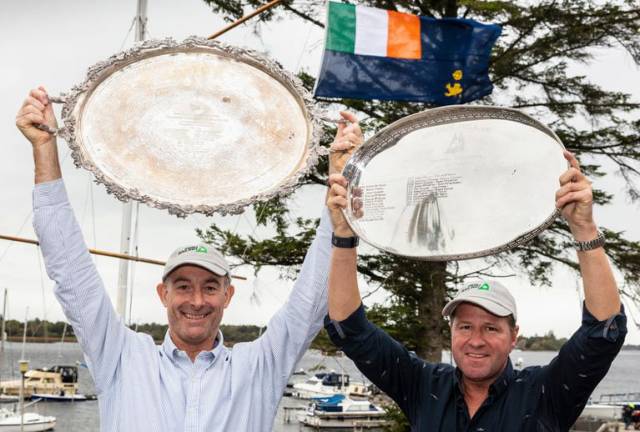The Champion of our Sailing Champions? Ireland first ran with the idea 72 years ago. And while other countries have since come up with their own versions with varying levels of success which have sometimes reduced annually until fading away, we’ve simply kept the Helmsmans Championship – as it was called at its inauguration in 1947 – on the road in one form or another. And now with, a Junior Championship traditionally held a week in advance, it’s as much an established a part of our lives as……well, as Christmas.
But while Christmas has gone through many mutations to reach its current over-the-top version, the Irish Sailing All-Ireland Helmsmans Championship - in both its Senior and Junior versions – is a very focused affair of intense interest among those who have qualified to take part and those who organise it, yet it has never become the spectator-attracting spectacle some might expect.
Admittedly, were the resources available to cover it with the sort of technological wizardry that the likes of Stan Honey and others have developed for the international mega-events, there’d be greater interest at the time. But that wouldn’t result in spectators being out on the water as September turns into October and suddenly there’s a real nip in the air, for all you’d need is access to a functioning screen and somewhere warm to sit.
Either way, it is very important to the Irish sailing community to know that each year, the All-Ireland Sailing Championship takes place. And perhaps with drone coverage of our racing increasing by the day, it will be of extra interest to see what emerges from the Junior Championship this weekend in Schull, where they’ll be racing the Davy Harte-developed TR3.6 which has done such sterling work – mostly in junior sailing - since its introduction in 2011.
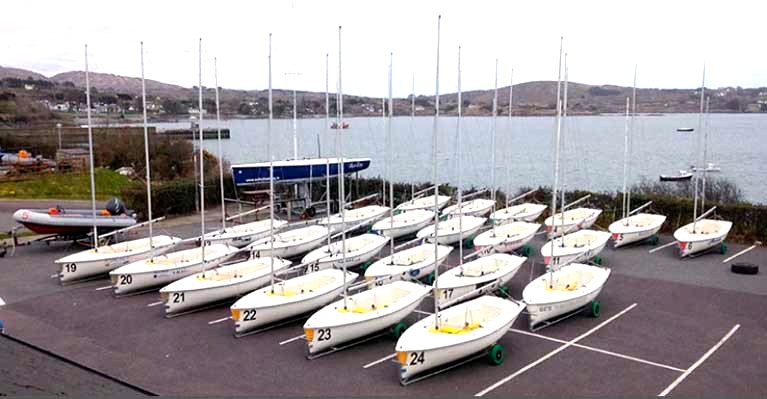 The Schull Package….West Cork’s race-ready TR3.6 class provides robust boats ideal for Team Racing and Junior Championships
The Schull Package….West Cork’s race-ready TR3.6 class provides robust boats ideal for Team Racing and Junior Championships
The Schull lineup is truly all-Ireland, as they range all the way from Topper champion Ethan McCormac from Cushendall S & BC in the Glens of Antrim in the northeast to Laser Radial sailor Micheal O’Suillebhain of Kinsale in the deep south, while the most westerly is Mirror champion Eoghan Duffy of Lough Ree, with the east coast well represented all the way from County Antrim down to Dublin Bay.
Staging a Junior Championship poses two particular problems, notably that defending champions may no longer be a Junior when the next year’s event comes around, and most junior racing is done in single-handed boats. So certain crusty old salts who advocate the building of teamwork in crewing welcome the Junior Championship simply because it forces divas of both genders to sail with somebody else in the boat….
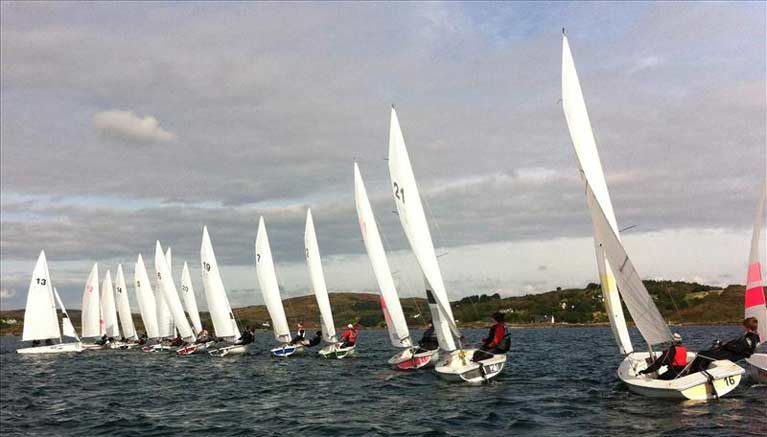 The Juniors racing at Schull. For many, it’s something of a culture shock, as so much junior racing takes place in single-handed boats.
The Juniors racing at Schull. For many, it’s something of a culture shock, as so much junior racing takes place in single-handed boats.
However, we’ll go no further down that particular heat-inducing road and instead will get on into the Seniors listing. But just for now, here’s this weekend’s lineup at Schull, although at the time of writing, it looks as though far west Cork is going to be on the front line of some very unsettled post-equinoctial weather, though it’s amazing what can be managed in a place like Schull with its geographical advantages and experienced race administrators.
|
Class |
Helm Name |
Helm Club |
Crew Name |
|
Laser 4.7 |
Michael Crosbie |
Royal Cork Yacht Club |
Ben O'Shaughnessy |
|
Laser Radial |
Clare Gorman |
National Yacht Club |
Conor Gorman |
|
Optimist |
Luke Turvey |
Howth Yacht Club |
Harry Pritchard |
|
Mirror |
Eoghan Duffy |
Lough Ree Yacht Club |
Cathal Langan |
|
Optimist |
Sorcha Gannon O'Connor |
Howth Yacht Club |
Leah Rickard |
|
29er |
Rian Geraghty-McDonnell |
National Yacht Club |
Nathan Van Steenberge |
|
Topper |
Darragh Collins |
Royal Cork Yacht Club |
Oisin McSweeney |
|
Laser 4.7/Team Racing |
Alana Coakley |
Royal St George Yacht Club |
Tara Coakley |
|
Laser Radial |
Micheal O'Suilleabhain |
Kinsale Yacht Club - Royal Cork Yacht Club |
Justin Lucas |
|
Topper |
Hannah Dadley-Young |
Ballyholme YC |
Zoe Whitford |
|
Intl 420 |
Lucy Kane |
East Antrim Boat Club |
Ben Graf |
|
RS 200 |
Chris Bateman |
Monkstown Bay Sailing Club - Royal Cork Yacht Club |
Olin Bateman |
|
Laser 4.7 |
Ellen Barbour |
County Antrim Yacht Club |
Eva Briggs |
|
ITRA |
Trevor Bolger |
Royal St George Yacht Club |
Russell Bolger |
|
Topper |
Ethan McCormac |
Cushendall Sailing & Boating Club |
Tom Coulter |
|
ITRA |
Harry Twomey |
Royal Cork Yacht Club - Cork Harbour Sailing Club |
Killian O'Regan |
The Seniors are racing at the National Yacht Club in Dun Laoghaire in a week’s time, and the selected boat is the Flying Fifteen. Certainly, the NYC’s FF fleet is in mint order at the moment after the top boats were tuned-up for the recent Worlds in Dublin Bay. And as a keelboat/dinghy crossover, the Flying Fifteen offers a compromise of sorts when you’re trying to accommodate all spectrums of racing, even if they have to do this series without using the spinnakers.
 The Flying Fifteens in Dublin Bay. For the All-Ireland Championship, they’ll be racing without the use of spinnakers. Photo: Afoat.ie/David O’Brien
The Flying Fifteens in Dublin Bay. For the All-Ireland Championship, they’ll be racing without the use of spinnakers. Photo: Afoat.ie/David O’Brien
But nevertheless last week’s parade of the nucleus of a class of Elliott 6s at the NYC will cause a certain amount of yearning in helms from the more athletic classes, as the very attractive New Zealand-originating Elliotts undoubtedly have a special buzz to them, as they’re for all the world like giant Fireflies with a very helpful deep bulb keel. So doubtless in due course, they’ll join the long list of boats which have had their moment in the sun as the boat of choice for the Helmsman’s Championship.
Meanwhile, last year’s championship on Lough Ree was sailed in SB20s and won by SB20 national champion Peter Kennedy of Strangford Lough. But there might be a genetic outcome to the big one in a week’s time, as Peter’s parents Terence and Bridget Kennedy were Flying Fifteen British Champions in 1962 when SLYC was a formidable presence in the class, notching more than one world title.
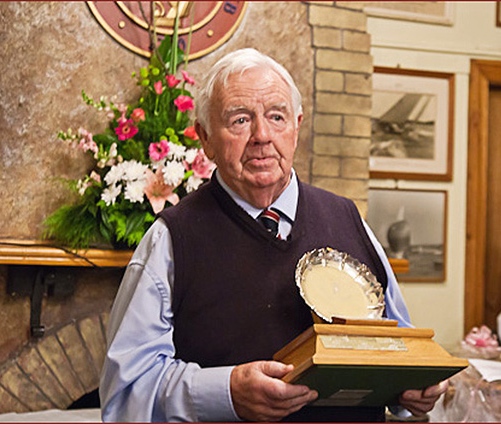 Ted Crosbie of Cork, winner in 1950 at Dunmore East, is senior title-holder. Photo: Robert Bateman
Ted Crosbie of Cork, winner in 1950 at Dunmore East, is senior title-holder. Photo: Robert Bateman
Whatever the outcome, Irish sailors will know that’s all well with the world of our sailing eight days hence, when the All-Ireland Champion 2019 holds the well-worn salver aloft in time-honoured style. So how do we come to have this piece of silverware which has come to mean so much?
It’s difficult now to imagine the world of 1946. For although sailing continued in Ireland as it did in Sweden and Switzerland during World War II from 1939 to 1945 thanks to national neutrality (with many allied servicemen availing of this during their leave periods to get a bit of relaxation from war), the reality is that it took some time to get some semblance of normality back into everyday life afloat and ashore.
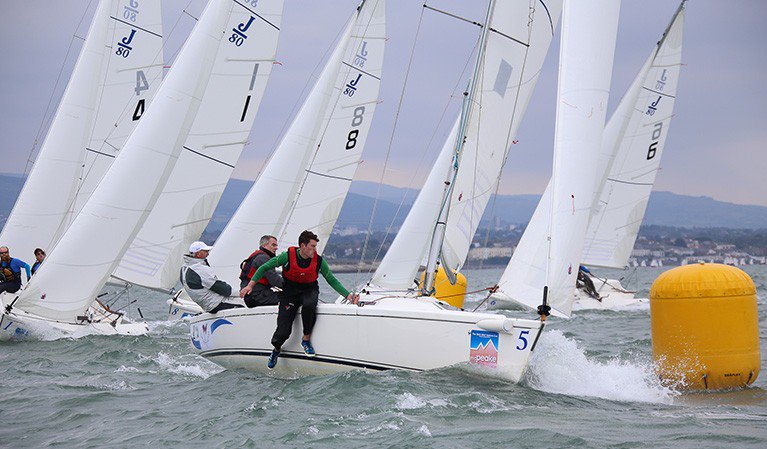 Double winner Anthony O’Leary (RCYC) on his way to his second victory in 2015, racing J/80s in Dublin Bay. Photo: Afloat.ie/David O’Brien
Double winner Anthony O’Leary (RCYC) on his way to his second victory in 2015, racing J/80s in Dublin Bay. Photo: Afloat.ie/David O’Brien
At that time, far and away the biggest dinghy class in Ireland was the International 12, in which Jimmy Payne of Crosshaven was an international star. The only other dinghy classes of any significance were the Water Wags in Dun Laoghaire, founded 1887 and racing to a “new” design since 1900, the Shannon One Designs from 1922, and the 17ft Dublin Bay Mermaids, which barely counted as dinghies.
Across in England and on the Continent, some exciting new ideas in dinghy design were developing and expanding their numbers, the top pace-setters being the International 14s. But in Ireland, although in 1937 three pioneers in Howth had boats built to the new Yachting World magazine-sponsored Uffa Fox design for the National 18 class, the handy little International 12s remained totally dominant at a nationwide level.
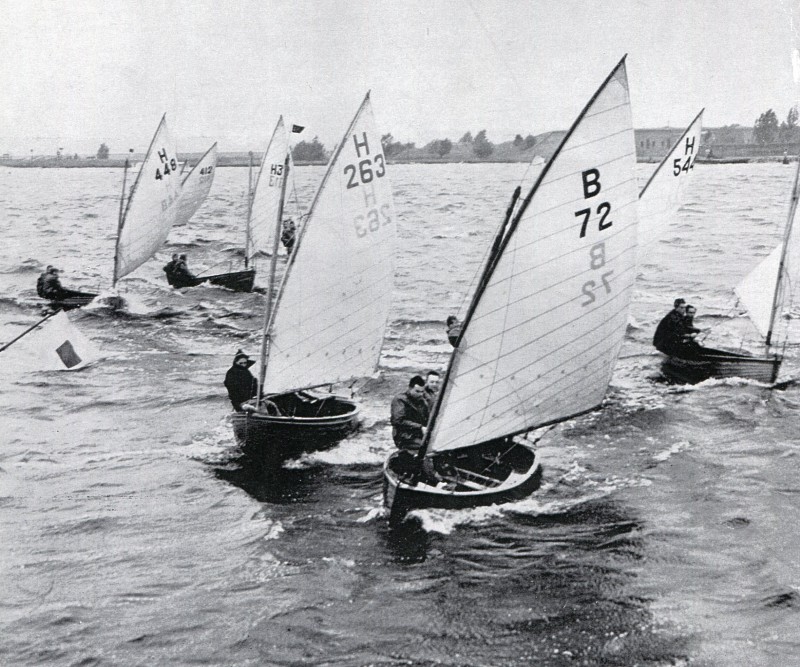 In 1946, the International 12s were the most popular dinghy class in Ireland, and Jimmy Payne of Crosshaven had won national and international prizes in the class.
In 1946, the International 12s were the most popular dinghy class in Ireland, and Jimmy Payne of Crosshaven had won national and international prizes in the class.
As peace took hold in 1946, they were sailed at so many Irish centres that the time had come for the somewhat relaxed Irish attitude to the International 12 design rules to be more strictly codifed. Thus in 1946, the Irish Dinghy Racing Association was brought into existence with its primary purpose and first rule being (and I quote):
“(1) To obtain agreement amongst the owners of the 12ft International Dinghies on the limits of deviation from the strict I.Y.R.U. (International Yacht Racing Union) plan and specification which will in future be generally accepted.”
The birth myth of what is now Irish Sailing would have it that our National Authority mutated out of the Irish Sailing Association which in turn emerged from the Irish Yachting Association which has in turn been a completed re-branding around 1960-62 of the Irish Dinghy Racing Association which in its turn - according to the legends of our forefathers - had been born of a wave of idealism in 1946 aimed at introducing modern dinghy racing to Ireland after the end of World War II.
But the banal reality is that rule-bending in the International 12ft Dinghy Class signalled the inauguration of the new organisation. Nevertheless, there probably was this high-flown ambition to give Ireland some rocket-assisted propulsion into the front line of mid-20th Century dinghy racing among people like Billy and Jimmy Mooney and the Delany family and others. But the lackadaisical attitude to the International 12 measurement rules – which had been readily indulged by local boatbuilders keen to expand their business – provided a very tangible issue on which to establish the new body.
The first Honorary Secretary was Jimmy Mooney of Dun Laoghaire while the Hon.Treas was Jem Sullivan of Sutton across Dublin Bay – both of them were ace International 12 racers who regularly sailed their little boats across the open bay to each other’s venues.
The Committee was Ronald Greene (Strangford & Belfast Loughs), Michael Sullivan (Cork), Captain James Payne (Crosshaven), Peter Odlum (Dun Laoghaire) Harry Deane (Cork), W. L. McClelland (Sutton), Charlie Sargent (Clontarf), Joe Fitzgerald (Cobh) and Reggie Pilkington (Dun Laoghaire).
It was, however, in their choice of President that the new Association showed its genius, for they persuaded Douglas Heard to take on the role. He was Irish by adoption. Having been seriously wounded while very young on active service in World War I, he’d been invalided out but eventually recovered sufficiently to go into the Welsh end of the management side of the City of Cork Steam Packet Company which was mainly focused on the Cork-Swansea route. Of a distinguished family in southeast Wales, despite his injuries he sailed regularly at the Mumbles, and during the 1930s was something of a force in the developing International 14ft dinghy class, and a close friend of innovative designer Uffa Fox.
 An International 14 dinghy in the 1930s, when Douglas Heard was regularly racing in Britain in this developmental class.
An International 14 dinghy in the 1930s, when Douglas Heard was regularly racing in Britain in this developmental class.
Business demands of the ferry service brought him to Cork for a period in the mid-1930s, and he found life in Ireland congenial. As an offshore sailor in addition to his dinghy interests (he did the 1939 Fastnet on sailmaker Chris Ratsey’s Fife sloop Evenlode), he had become a member of the Irish Cruising Club in 1935, while his Cork sailing involvement extended to buying and racing the Cork Harbour One Design Imp
He continued his involvement with the major championships of the International 14 Class in England, while his life in Ireland developed to a directorship of a sister company to the Cork operation, the British & Irish Steam Packet Company (later the B&I Line) in Dublin, where he became a member of the Royal St George YC in 1942. At first, he seemed a somewhat shy and reserved man, but he usually had projects on the go and had the gift of productive friendships, becoming close to ICC Commodore Billy Mooney and his son Jimmy, to the Delany family, and with Rory O’Hanlon and many others, and in time he settled in Killiney.
So when he was asked to be President of this new Association, he accepted and presented it with a large silver salver which was to be awarded to the champion of the new class which he and others were persuading the IDRA to promote, the IDRA 14 designed by O’Brien Kennedy. It was almost embarrassing when Douglas himself won the first championship in 1947, but things were developing rapidly, in 1948 it was won by John Wearing of Sutton who later went on to become a sort of One Man Maintenance Unit on Ireland’s inland waterways. By 1949 the scope of the championship was expanding, with the IDRA 14s and the new Uffa Fox-designed series-produced 12ft Firefly class making such inroads into Irish sailing that the old International 12s were disappearing like snow off a ditch.
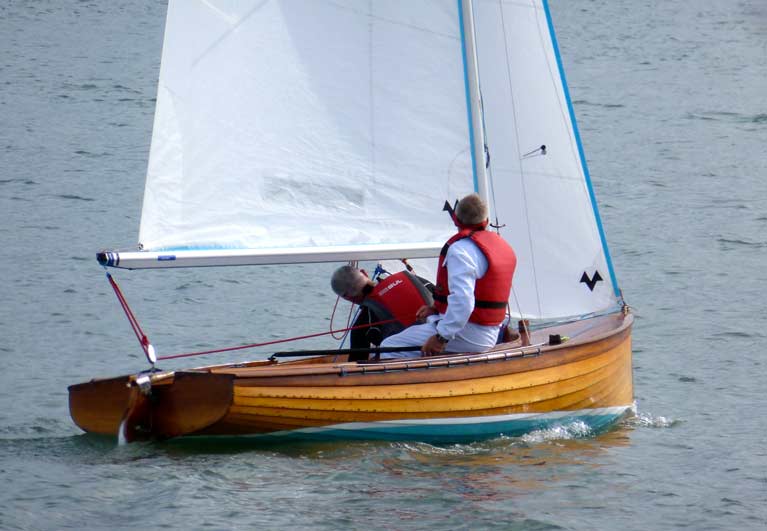 The IDRA 14 Dusk, one of the most successful in the class, being raced by Gerry Sargent whose father Charlie was a founding committee member of the Irish Dinghy Racing Association in 1946. Photo: W M Nixon
The IDRA 14 Dusk, one of the most successful in the class, being raced by Gerry Sargent whose father Charlie was a founding committee member of the Irish Dinghy Racing Association in 1946. Photo: W M Nixon
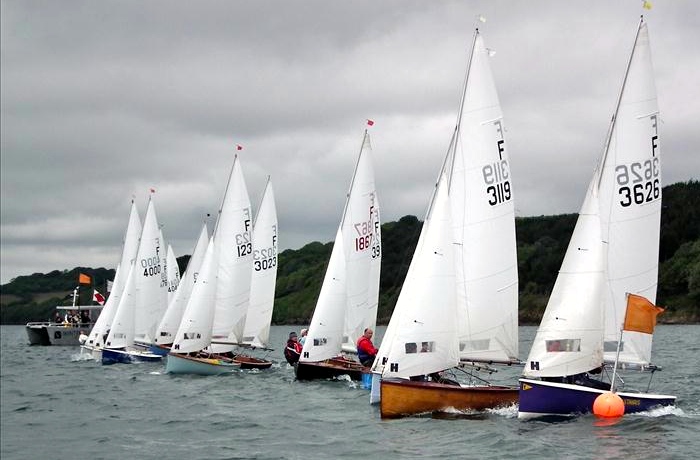 The advent of the Firefly Class in Dun Laoghaire in 1947-48 effectively spelt the end of the old International 12 dinghies.
The advent of the Firefly Class in Dun Laoghaire in 1947-48 effectively spelt the end of the old International 12 dinghies.
The notion of an IDRA Dinghy Week for all classes was developing by the end of the 1940s, when the emerging Helmsmans Championship for Douglas Heard’s salver was staged with the top helms from each class racing for one day at the end of the week, and this saw it in 1949 going to Dick Uren, a Firefly sailor from across channel who raced out of West Kirby SC.
By 1950 Dinghy Week was a fully-fledged event, a moveable feast which was a highlight of the annual Irish sailing calendar, and in 1950 it was staged in Dunmore East by Waterford Harbour SC, with cruisers from Dun Laoghaire and Cork such as Aylmer Hall’s 12 Metre Flica and Clayton Love’s ketch Galcador going along to provide floating accommodation for the dinghy racing crews, with Crosshaven’s own Teddy Crosbie crewed by Mick Sullivan winning the Helmsman’s Championship on the final day.
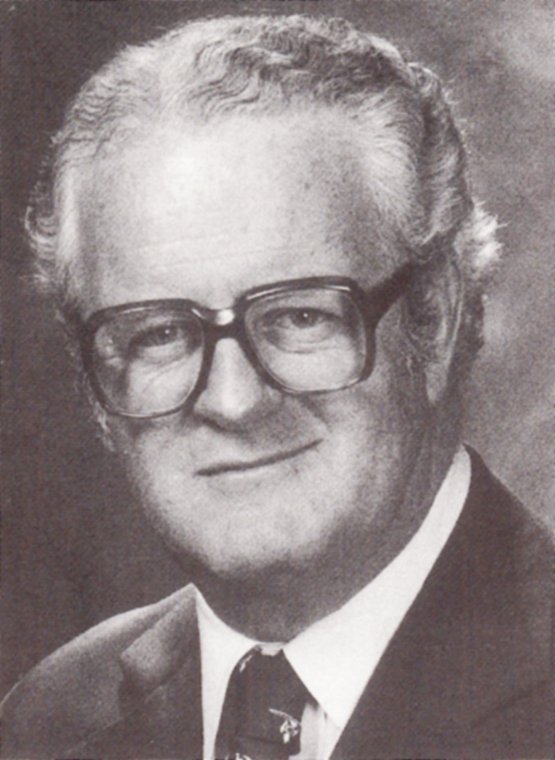 Clayton Love, winner of the Helmmsmans Championship in 1955 and 1960, also oversaw the transformation of the Irish Dinghy Racing Association into the Irish yachting Association in 1960-62, and the amalgamation of the Royal Cork and Royal Munster YCs in 1967.
Clayton Love, winner of the Helmmsmans Championship in 1955 and 1960, also oversaw the transformation of the Irish Dinghy Racing Association into the Irish yachting Association in 1960-62, and the amalgamation of the Royal Cork and Royal Munster YCs in 1967.
And Teddy Crosbie is of course still with us, as indeed is an incredible collection of former winners of the mighty Douglas Heard-donated salver. So for young folk lining up for this weekend’s Junior Championship in Schull, if you have a long and worthwhile life in mind, be sure in due course to aim for the senior title. For when you think that the 1952 & 1954 winner Neville Maguire of Howth is still about in boats, you get some idea of the longevity extended. For also still very much with us is Clayton Love Jnr, winner in 1955 and 1960, who in the 1960s saw the IDRA become the ISA, and in that same decade brought the Royal Cork and the Royal Munster Yacht Clubs together to provide the strong organization which enabled the Royal Cork to celebrate its Quadrimillennium in 1969-1970, and now he’s here to see it mark its Tricentenary in 2020.
The list of past Senior and Junior winners speaks for itself:
|
Year |
Senior Winner |
Junior Winner |
Junior First Girl |
|
2018 |
Peter Kennedy |
Atlee Kohl |
Alana Coakley |
|
2017 |
Fionn Lyden |
Micheal O’Suilleabhain |
Leah Rickard |
|
2016 |
Alex Barry |
Johnny Durcan |
Kate Lyttle |
|
2015 |
Anthony O'Leary |
Peter McCann |
Clare Gorman |
|
2014 |
Anthony O'Leary |
Harry Durkan |
Gemma McDowell |
|
2013 |
Ben Duncan |
Séafra Guilfoyle |
Megan Parker |
|
2012 |
Peter O'Leary |
Fionn Lyden |
Aisling Keller |
|
2011 |
George Kenefick |
||
|
2010 |
Nicholas O'Leary |
Philip Doran |
Sophie Murphy |
|
2009 |
Nicholas O'Leary |
Matthew O'Dowd |
Diana Kissane |
|
2008 |
Nicholas O'Leary |
Philip Doran |
Tiffany Brien |
|
2007 |
Stefan Hyde |
Chris Penney |
Annalise Murphy |
|
2006 |
Peter O'Leary |
George Kenefick |
Rachel Guy |
|
2005 |
David Crosbie |
Fionn Jenkinson |
Lisa Tate |
|
2004 |
Tom Fitzpatrick |
Katie Tingle |
|
|
2003 |
Neil Hegarty |
Erica Tate & Lorraine Stallard |
|
|
2002 |
Conor Walsh |
Robert Collins & Kenny Keogh |
|
|
2001 |
Feargal Kinsella |
Peter Bayly & Niall Cowman |
|
|
2000 |
Gerald Owens |
Peter O'Leary |
|
|
1999 |
Mark Mansfield |
Nicholas O'Leary |
|
|
1998 |
Tom Fitzpatrick |
Gerald Owens |
|
|
1997 |
Tom Fitzpatrick |
Neil Spain |
|
|
1996 |
Laura Dillon |
Gerald Owens |
|
|
1995 |
Ruan O'Tiarnaigh |
Laura Dillon |
|
|
1994 |
Tom Fitzpatrick |
Evan Dolan |
|
|
1993 |
Sean Craig |
Evan Dolan |
|
|
1992 |
John Ross Murphy |
Tom Fitzpatrick |
|
|
1991 |
Mark Lyttle |
Tom Fitzpatrick |
|
|
1990 |
Mark Mansfield |
Robert Eason |
|
|
1989 |
Marshall King |
Conal Casey |
|
|
1988 |
John Murtagh |
J McWilliam |
|
|
1987 |
Mark Lyttle |
Dan O'Grady |
|
|
1986 |
Mark Lyttle |
T McWilliam |
|
|
1985 |
Paul Rowan |
Nicky Timon |
|
|
1984 |
Paul Rowan |
Niall Alexander |
|
|
1983 |
Brian Craig |
Niall Alexander |
|
|
1982 |
David Cummins |
Michael Stavely |
|
|
1981 |
David Cummins |
Mark Lyttle |
|
|
1980 |
T W Whisker |
Justin Maguire |
|
|
1979 |
Chris Arrowsmith |
Justin Maguire |
|
|
1978 |
Wiclif McCready |
John Gilmore |
|
|
1977 |
Wiclif McCready |
Mark O'Hare |
|
|
1976 |
Adrian Bell |
Bryan Maguire |
|
|
1975 |
David Gay |
Joseph English |
|
|
1974 |
Peter Duffy |
Alan McFarlane |
|
|
1973 |
Owen Delany |
David McFarlane |
|
|
1972 |
Harold Cudmore |
Robert Bleakney |
|
|
1971 |
Adrian Bell |
||
|
1970 |
Robert Dix |
||
|
1969 |
Maurice R Butler |
||
|
1968 |
Vincent Delany |
||
|
1967 |
T C M Morris |
||
|
1966 |
John F Russell |
||
|
1965 |
James Nixon |
||
|
1964 |
J K O'Reilly |
||
|
1963 |
Owen Delany |
||
|
1962 |
G M Sargent |
||
|
1961 |
M C Walsh |
||
|
1960 |
J Clayton Love Jnr |
||
|
1959 |
J O McCleary |
||
|
1958 |
J K O'Reilly |
||
|
1957 |
J Somers Payne |
||
|
1956 |
J Somers Payne |
||
|
1955 |
J Clayton Love Jnr |
||
|
1954 |
Neville D Maguire |
||
|
1953 |
Johnny Hooper |
||
|
1952 |
Neville D Maguire |
||
|
1951 |
Richard Uren |
||
|
1950 |
Ted Crosbie |
||
|
1949 |
Richard Uren |
||
|
1948 |
John Wearing |
||
|
1947 |
R Douglas Heard |
The great Douglas Heard went from among us in 1983 at a very considerable age, but by that time he’d pushed the boat out in other directions, with the hugely innovative Flying Thirty Huff of Arklow designed by Uffa Fox and built by Jack Tyrrell in 1950, promoting fin-and-skeg configuration a good fifteen years before the rest of the offshore racing world caught up.
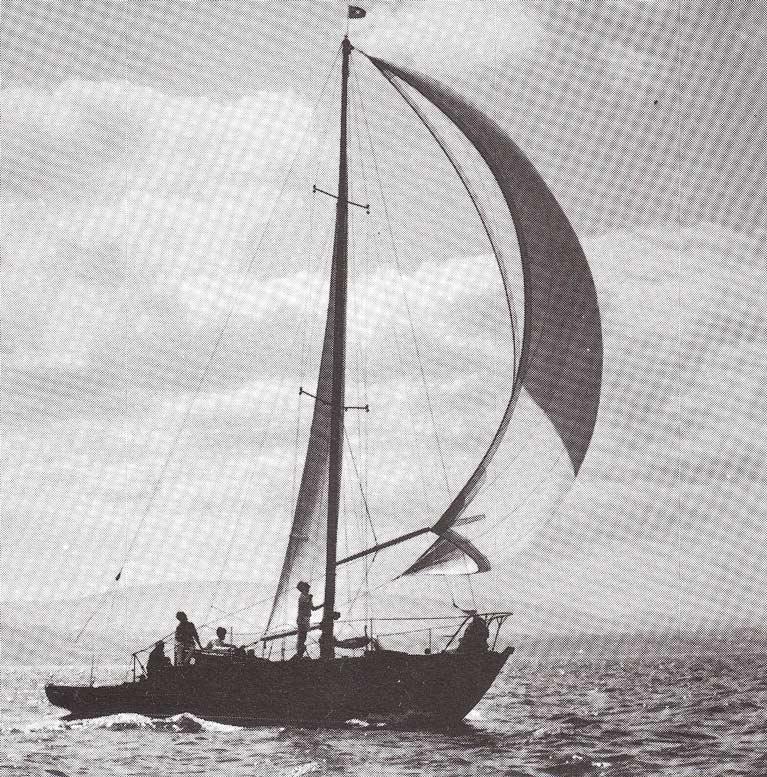 Douglas Heard’s pioneering “Flying Thirty” Huff of Arklow raced offshore and inshore and cruised to Iceland and the Azores.
Douglas Heard’s pioneering “Flying Thirty” Huff of Arklow raced offshore and inshore and cruised to Iceland and the Azores.
He raced Huff offshore and cruised her extensively while moving up the administrative structure of the Royal St George to become Commodore in 1960 for a five-year term of office. He also became much involved with the Inland Waterways, making what everyone thought would be the last-ever transit of the Royal Canal in 1954, but then worked assiduously behind the scenes with many others in the IWAI to promote the restoration of our waterway to their current healthy state.
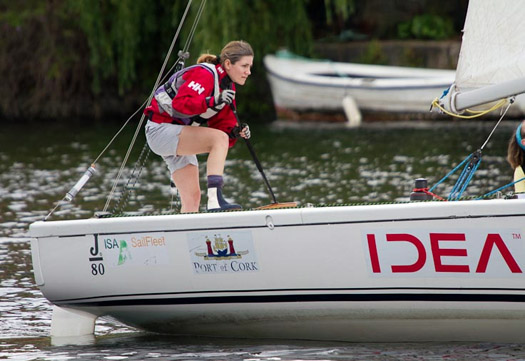 Laura Dillon of Howth, winner in 1996, is still the only woman champion
Laura Dillon of Howth, winner in 1996, is still the only woman champion
As for the Helmsmans Championship which he had the vision to inaugurate in 1947, by the 1970s Dinghy Week had become so large that no single club would willingly undertake it, so classes or groups of classes staged their own national championships and the Helmsmans Championship became a standalone event traditionally staged in late September or early October, using different venues and usually different boats each year.
So when that salver is lifted aloft at the National Yacht Club by the All Ireland Champion 2019 on the evening of Sunday, October 6th, you’re looking at something which symbolizes just about everything that is best in Irish sailing. With a week to go, the confirmed entries (helms left column) are:
|
Cathy MacAleavey |
Water Wags |
National Yacht Club |
Con Murphy |
|
Robert Espey |
RS400 |
Ballyholme Yacht Club |
Andrew Baker |
|
David Gorman |
Flying Fifteen |
National Yacht Club |
Chris Doorly |
|
Sean Craig |
Laser Radial |
Royal St. George Yacht Club |
Alan Greene |
|
Peter Kennedy |
2018 Champion (SB20) |
Strangford Lough Yacht Club |
Stephen Kane |
|
Darren Wright |
ICRA IRC 2 |
Howth Yacht Club |
tbc |
|
Rory Fekkes |
ICRA IRC 3 |
Carrickfergus Sailing Club |
Paul Fekkes |
|
Jonathan Horgan |
Shannon One Design |
Lough Derg Yacht Club |
Carden Kent |
|
John Sheehy |
Team Racing |
Royal St. George Yacht Club |
Darragh O'Connor |
|
Ronan Wallace |
Laser Standard |
Wexford Harbour Boat & Tennis Club |
Brendan Wallace |
|
Michael O'Connor |
SB20 |
Royal St. George Yacht Club |
Davy Taylor |
|
Gordon Patterson |
Squib |
Royal North of Ireland Yacht Club |
Ross Nolan |
|
Paddy Dillon |
Mermaids |
Rush Sailing Club |
Johnn Dillon |
|
Shane MacCarthy |
GP14 |
Greystones Sailing Club |
Stephen Boyle |
|
Colm O'Flaherty |
J24 |
Sligo Yacht Club |
Dave O'Connor |
|
Wyatt Orsmond |
Multihull IMA |
Swords Sailing Club |
Patrick Billington |
 Giants of Irish sailing history: Denis Doyle, Joe Fitzgerald and Douglas Heard relaxing at an Irish Cruising Club Shannon Rally, October 1977. Photo: W M Nixon
Giants of Irish sailing history: Denis Doyle, Joe Fitzgerald and Douglas Heard relaxing at an Irish Cruising Club Shannon Rally, October 1977. Photo: W M Nixon



























